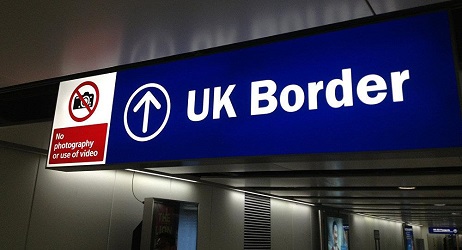
‘The migrant crisis’, Really a crisis?
by Asia Braithwaite
In the UK, migration has become an important part of popular discourse. The movement of people has become a source of political debate and a reoccurring theme in the media and tabloids. Therefore I find it important to address some issues surrounding the term migration, and the ever growing ‘migrant crisis.’ What constitutes a ‘migrant?’, why are some migrants seen as more problematic than others?, how do the media feed into negative depictions of migrants?, and is nationalistic sentiment just an excuse to spread xenophobic and racists ideologies?.
A migrant is anyone who moves from one place to another, whether that be someone who is seeking refuge, a student, or someone who wishes to move for job opportunities. However, some migrants are considered more problematic than others. This is because the image of a ‘migrant’ is a social construct, which can be manipulated positively or negatively. A representation is the depiction of things, events, and people. This can include symbolic forms of representation. This gives meaning through language and visual image and engages feelings, attitudes and emotions and can occasionally be used to mobilise fear. They are fluid and adapt to different social contexts.
The representation of migrants in media discourse has evoked fear and panic which has been the dominant depiction over the past few years. Migrants have been depicted as subhuman, and as lacking the same culture and morals as the British public. Migrants have also been perceived as someone who has recently arrived to the UK, although many migrants have been in the UK for a long period of time. Sociologist, Peter Gale analyses the 2001 elections in Australia and the merging of populist politics (politics that appeals to the most popular opinion) and media discourse. The 2001 election was centred on border protection. Within this election the terms ‘refugee’ and ‘asylum seeker’ were used interchangeably in the media. Fear inducing narratives were endorsed by the media in order to coincide with populist politics.
Gale identifies three representational themes within media discourses representation of migrants and migration. The first would be ‘the humanitarian Crisis’, which uses the metaphor of the ‘human faces’ of refugees. This presents Australia as kind and liberal for allowing refugees, however the media still perpetuate contradictory ideologies by representing refugees as immoral and subhuman. The second representational theme in media discourse is ‘Border Protection and our rights as a nation.’ In which border control is represented as being for the good of the nation. Represents the opening of borders as a threat to the nation and also constructs a ‘crisis.’ The last representational theme is the least prominent within media discourse. ‘Human rights and media discourse’ emphasises the ‘pursuit of truth’ and highlights the global and historical concept of asylum seekers. It attacks the ‘facts’ made by tabloids and other media sources.
In order to truly understand how these representational themes operate, it is important to look at this through the current state of affairs.
Currently, populist politics and media discourse have placed much emphasis on the ‘migrant crisis’ describing the migration of Syrian refugees. In the wake of a chemical gas attack on Syrian civilians by the Syrian government, Trump ordered airstrikes on the Syrian government. Gregor Krieg writing for CNN asks “will the Syria chemical attack change Trump’s mind about refugees?” Krieg points towards Trump’s concern for the matter however also his refusal to admit more refugees into the US. Trump “argued that this new military action could reverse the ongoing disaster” but did not mention the refugee crisis. Hilary Clinton responded by arguing “‘I hope that they recognise that we cannot in one breath speak of protecting Syrian babies and in the next close American doors to them.” This contradictory ideology exemplifies ‘The humanitarian Crisis’ within media. The US is being represented as being a saviour for retaliating to the chemical gas attack. Trump’s reference to ‘beautiful Syrian babies’ portrays the metaphor of refugees having a ‘human face’ whilst simultaneously refusing to provide them with refuge in the U.S.
In the UK, The Daily Mail are one of the main culprits for perpetuating negative stereotypes of refugees. This was extremely prominent during Brexit, and supported the xenophobic policies of UKIP. The daily mail perpetuate images of migrants (especially refugee’s) as being sub-human , dangerous, and immoral in order to fuel mass hysteria, as seen in articles such as ‘2 Afghan migrants held for forcing women into prostitution’, which place migrants as the focal point of the title. These fear inducing stories were extremely prominent in the tabloids during the time of the Brexit elections. The Daily Mail perpetuate the representational media theme of Border Protection and our rights as a nation.’ With stories titled ‘Britain needs a five-year freeze on unskilled workers to push migration levels down to less than 50,000, say leading brexiteers.’ This creates an ‘us vs them’ ideology and also assumes that all migrants are unskilled.
Since ‘national borders’ are merely a social construct, why do the media perpetuate an ‘us vs them’ mentality when it comes to migration? This may be explained by Stuart Hall’s idea that subtle forms of racism have emerged with symbolic national boundaries of inclusion and exclusion. There is a ‘culture of fear’ in western societies fuelled by nationalistic ideology. Hall points towards the prominence of nationalist politics, propagated by Margret Thatcher who employed the threat of black immigration recognised as post-modern racism. This form of ‘nationalism’ emphasises cultural differences, and represents the ‘nation’ as a very real thing, rather than a social construct. Stuart Hall argues that the government perpetuate imagined communities and ‘Britishness.’
Borders are not real. Borders have been created, and are currently being used by the media and politicians to include some and exclude others.
References
Gale, Peter, ‘Populist politics and media discourse’, Journal of Sociology, Vol. 40, No.4. 321- 340.
Header picture – (Sputniknews) Accessed on: 13.05.2017

0 Comments